Does
Light Color Affect Growth
and Phototropism of Lima Bean Seedlings?
1st
Place School Level - 6th Grade February 2002
1st Place Junior Division Plant Biology District Level - March 5-7, 2002
(RIMS County Compeition will be held April 23, 2002)
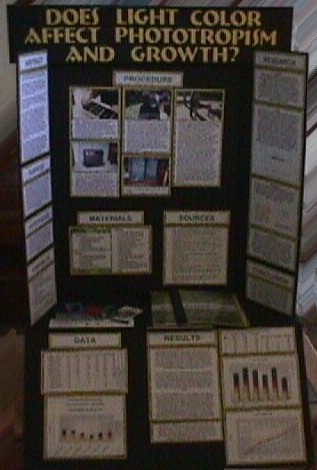 By Leah Schoelles |
The purpose of this experiment was to see if light color
affects growth and phototropism of lima bean seedlings.
I compared growth rates and reaction to light color among 5 seedlings.
I placed them in boxes with baffles. Then I placed the boxes under different
colored lights and in sunlight. I grew a separate plant outside of a box and
in sunlight as the control.
I measured height of the plants every twelve hours from the soil to the tip to the nearest 1/8" for seven days. I noted the reaction to light by how well the plants turned toward the light.
The results were that the total average growth of the plant in the box placed in sunlight was greater than the other plants. The red light plant was second, the incandescent light was third, the plant light plant was fourth, and the blacklight plant was last. The plants turned and reacted well to the sunlight and the incandescent light. They turned toward the red light two of three times. The plant light and blacklight plants hit the top baffle without turning. The plants with the least amount of growth had the least reaction to light.
My hypothesis should be partially rejected regarding growth. The plants grew in the order I predicted except the plant light was fourth instead of first. My hypothesis should be partially accepted regarding phototropism. Not all of the plants reacted to light - only 2 of the plants showed a reaction, 1 showed reaction 2:3, and 2 plants did not react at all. But, the plants with the least amount of growth also showed the least reaction to light, which is what I predicted.
The purpose of this experiment is to see if light color affects phototropism and growth of lima bean seedlings. I have read about experiments that show the effect of light on phototropism, and about experiments that use different colored lights to measure plant growth, but I have not seen the two combined. I became interested in this when I went on a nature hike in the mountains. A tree was growing out of a cave from a granite boulder, and it was bending towards the light. If we could change the conditions that plants grow in, maybe we can improve crops.
I think that the plants grown under the plant light will bend toward the light and grow faster than the other plants. The plant grown under sunlight will be second, the red light plants will be third, the incandescent light plants will be fourth, and the blacklight plants will be last. I base my hypothesis on research done by scientists that show plants grow better under red and blue light combined.
The constants in this experiment were:
· The type of seeds I used
· The type and size of the pots
· The soil and how deep I planted the seeds
· The amount of light and how far away the light was from the box
· The size of the box
The manipulated variable was:
· The color of light
The responding variables were:
· How much the seedlings grew each day
· How well the seedling responded to the light source
I measured the plants twice a day with a measuring tape to the nearest 1/8th of an inch. I noted how well the plants were turning toward the light by observing the curve of the stem.
|
Plant Growth:
1 packet Lima bean seeds 1 2 qt. bag potting soil 1 Starter pack with lid 4 cups water 1 heating pad 1 measuring tape to the 1/8th inch |
Boxes:
5 boxes with removable lids 4 cans flat black spray paint 3 sq. ft. cardboard 1 safety Knife 1 pair scissors 1 roll electrical tape |
Light Bar:
1 1"x4"x36" piece of wood 2 1"x4"x24" piece of wood 2 1"x1"x12" piece of wood 8 1 ½" wood screws 1 60/75 watt red spotlight 1 75 watt blacklight 1 60 watt incandescent light 1 60 watt plant light 4 light sockets 4 socket tubes 4 lock washers 2 cans flat black spray paint 8' 12/2 stranded cord wire 1 plug end 1 roll electrical tape 5 pieces of foam board 12"x23" 2 pieces of foam board 30"x23" 1 24-hour plug-in timer Drill |
ONE - I planted 12 Lima bean seeds 3 days before the beginning of the measuring. The seeds were planted in a 2" deep plastic starter set with a lid in potting soil at a depth of ½". The seeds were not fertilized. I put the starter pack on a heating pad set at low.
TWO - I made 5 boxes before the seeds sprouted. I cut two
baffles for each box out of cardboard so they would fit inside the box. I
cut a 2" round hole in the right 1/3 of each baffle, and taped them to
the inside of the box with electrician's tape at about the 1/3 and 2/3 level
with the holes on opposing sides of each other. I painted each box and lid
inside and out with black flat spray paint. Black flat paint absorbs light
and heat so the plant would grow toward the light source and be kept warm.
 |
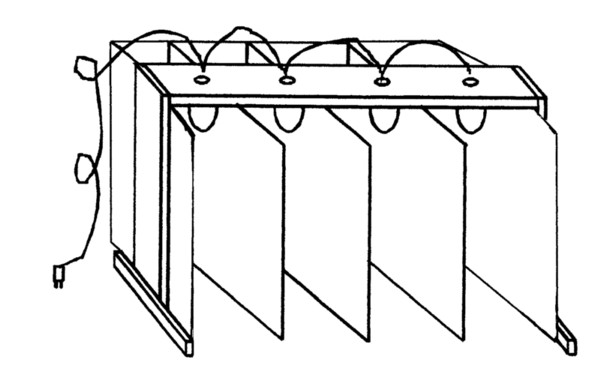 |
THREE - I built the light bar by screwing the 24" pieces of wood to the 36" piece to make legs. Then I screwed the 12" 1"x1" pieces to the bottom of the 24" lengths at a right angle to keep it standing up. I drilled 4 holes 7" apart in the top of the 36" length. I painted the entire bar with flat black spray paint. I tapped in the socket tubes and tightened a lock washer on the top to hold it in place. I screwed the sockets to the bottom of the tubes so they faced down. The wire was cut and attached from the first socket to the next and the next to make one circuit. The cord cap was attached and the bulbs put in place. I tested the bar to see if it worked. I took the 12" wide pieces of foam board and attached them with electrician's tape from end to end to one of the 30" wide pieces. I stapled the two end pieces to the sides to hold the foam board in place. This created cubicles for the boxes so they would get only their own light. Light in front was blocked off by the second piece of foam board rested against the light bar.
FOUR - I chose 6 good looking plants that were about 2"-3" tall to do my experiment. I cut them apart from the other plants in the starter pack and put them under the first hole in each box. I placed 4 boxes under the light bar and one in the greenhouse window. The last plant was placed in the greenhouse window, but was not put in a box. The timer on the light bar was plugged in and set to go on at 6:30 a.m. and off at 6:30 p.m. I watered and measured all of the plants twice a day for the next seven days at 7:00 a.m. and 7:00 p.m. I wrote each measurement down and noted how well the plants were responding to the light.
FIVE - I repeated steps 1 and 4 two more times.
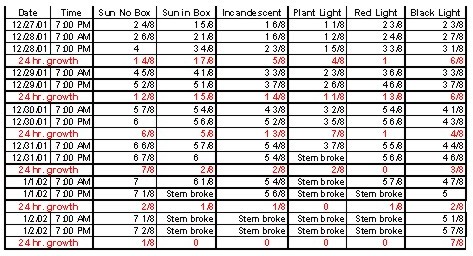
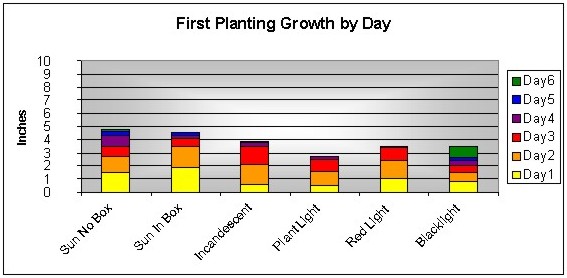
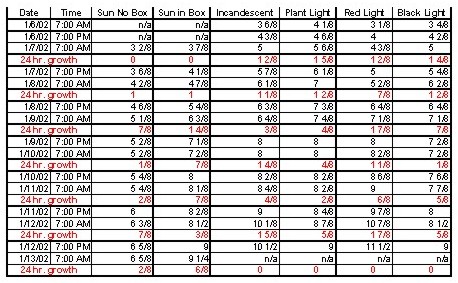

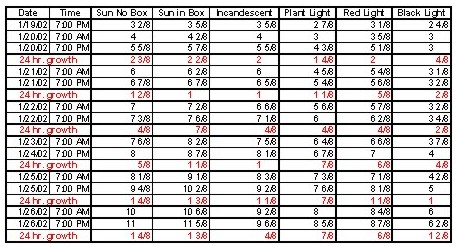
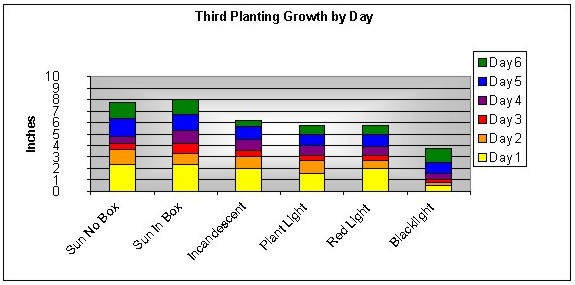
The original purpose of this experiment was to see if light color has an affect on growth and phototropism of Lima been seedlings. The results of the experiment were the plant grown in the box under sunlight had the highest average growth, the red light was second, the incandescent light was third, the plant light was fourth, and the blacklight was last. The plants with the highest growth turned toward the light the best.
Four of the plants in the first planting broke before the end of the experiment. I used the data from this planting only on the days that the plant grew to compute my averages. Two of the plants in the second set were too short to begin the experiment with the other plants, so these plants were measured a day later than the other four. The third set grew well and no problems were noted.
During each planting and on every plant grown inside a box, I noticed that the leaves were smaller and a yellow-green compared to the control plant grown outside of the box and in the sunlight. The stem on the control plant was shorter also. Although the plants in the boxes grew faster than the control, they looked less healthy.
All plants grew quickly on the first and second days, slowed their growth between the third and fifth days, and again grew quickly on the sixth day. The blacklight plant's growth was the most consistent from day to day.
If I were to do this experiment again, I would plant a different type of seed. I would also try this during the summer. I also wonder if the growth slow down during the third through fifth days is a normal occurrence in other plants.

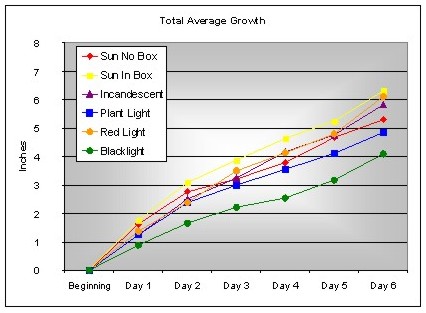
My hypothesis should be partially rejected regarding growth. The plants grew in the order I predicted except the plant light was fourth instead of first. My hypothesis should be partially accepted regarding phototropism. Not all of the plants reacted to light - only 2 of the plants showed a good reaction, 1 plant showed a reaction 2:3, and 2 plants reacted very little or not at all. The plants reacted to light in the same order as their growth, which is what I predicted.
Plants share six common characteristics. Seed bearing plants
are classified as dicot or monocot. All plants need soil, water and light
to grow. Visible light waves are broken into different colors. Plants use
each of the visible light colors for different purposes. Light quantity and
duration also have an effect on plant growth. A plant's reaction to light
is called phototropism. A hormone called auxin causes plants to turn toward
a light source. Lima beans are a food crop grown mainly in the Americas in
warm areas. They contain high levels of cyanide, but the poisons can be boiled
off and the seeds eaten as a source of vitamins and protein.
Plants - Plants have six things in common: Use of photosynthesis, possible unlimited growth, cells containing cellulose, no way to move from one place to another, no nervous system, and a history of alternation of generations. Seed bearing plants are classified as dicot or monocot. Dicot seeds have two seed halves, a rigid core, and a large taproot (like pine trees and rose bushes). Monocot seeds are not split in half, have a softer stem, and a large root system (like corn and crabgrass). All plants need soil, water and light to grow.
Light - Visible light waves are broken into different colors:
violet, indigo, blue, green, yellow, orange, and red. Blue light waves have
a faster frequency than red lights. Humans cannot see light waves that are
too fast, like ultraviolet, or too slow, like infrared.
Light has three characteristics that affect plant growth: quantity, quality,
and duration. Plants react to different light colors (quality) in different
ways. Green light is least effective to plants since most plants absorb very
little and reflect it back. This is why most plants look green. Blue light
is responsible for leaf growth. Red and blue light combined has the greatest
effect on plant growth and encourages flowering. Red light helps plants germinate.
Light quantity means how bright the light is, and duration is the length of
the day.

(Purves, 2001)
Phototropism - Tropisms are a plant's reaction to something. Phototropism is a plant's reaction to light. The cause of phototropism is an auxin. Auxin is a hormone that tells the side of the plant with the most shade to grow longer than the other side. This causes the plant to bend toward the light source.
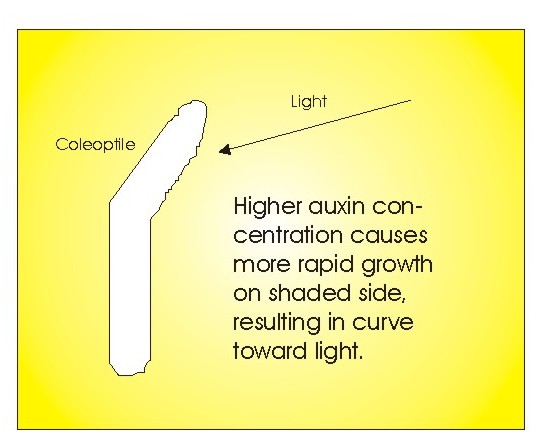
(Modified from Purves, 2001)
Lima Beans - Lima beans were first grown around Lima, Peru about 6,000 B.C. They contain high amounts of cyanide. Before they can be eaten, they must be thoroughly cooked to boil off all of the poison. Like most beans, they are rich in protein and vitamins B1 and B2. Lima beans are used very little outside of the Americas. They grow best in warm areas and are sensitive to cold water. They have a large root system. Aphids, grasshoppers, leafhoppers, and pod borers are some of the insects that invade Lima beans.
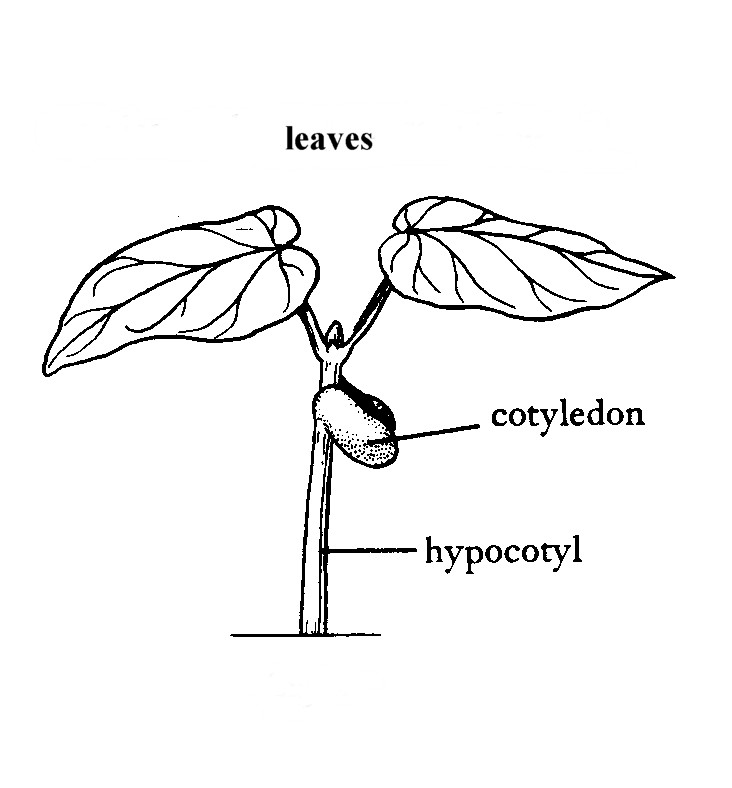
Bean seedling 10 days old
(Modified from Stone, 1983, p. 203)
BIBLIOGRAPHY
PRIMARY SOURCES
DOCUMENTS AND PHOTOGRAPHS
Schoelles, Diane. Prior Assistant Garden and Seasonal Buyer, The Home Depot, Inc. Moreno Valley, California. Original drawing of boxes and light bar.